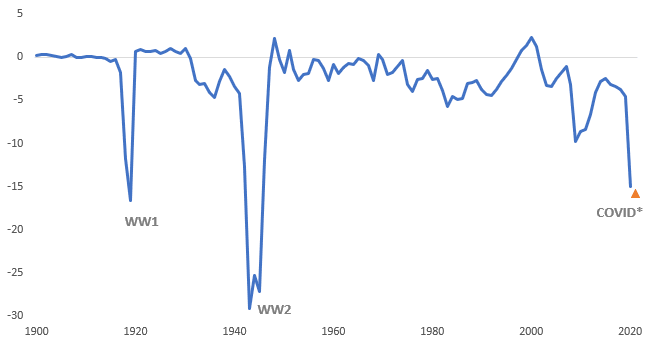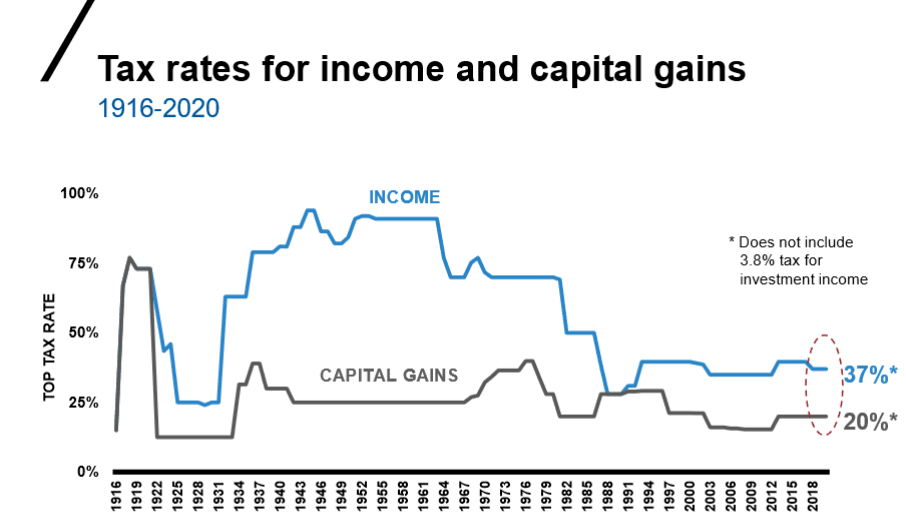How Are We Going To Pay For This? That’s The $5.7 Trillion Question
We are 14 months into what many of us would agree is one of the most disruptive crises we will experience in our lifetimes. The word unprecedented has been used so often, it almost makes the unnormal normal. Life has changed so much that previously unthinkable situations, such as having our children learning alongside us working from home and pets getting themselves involved in work meetings on Zoom, have become par for the course.
There is no question as to the severity of this pandemic from a health standpoint. And there is no question that this has led to a massive disruption to the functioning of the economy. In order to avoid an even worse scenario than what we have experienced (a significant economic depression), the economy needed support. It came—in the form of unprecedented stimulus from the U.S. government. How much stimulus? A LOT! My focus here is a domestic one, pertaining solely to the United States and the potential impacts of the stimulus measures on U.S. tax policy.
The bottom line
Let’s get right to it. What we are talking about is a MASSIVE sum of money in the form of economic stimulus. It’s significant in both its magnitude as well as the compressed period of time in which it was injected into the economy. The total sum as of right now is north of $5.7 trillion. Let that number sink in for a moment. That’s a lot of zeros.
This stimulus wasn’t just a one-time injection: it came in multiple tranches. With all the changes in our lives over the last year, it’s easy to lose track of everything being done to combat the pandemic. That includes mundane things such as all of the different tranches of fiscal stimulus.
(Click on image to enlarge)

Source: Federal Reserve Bank of St Louis; Wikipedia.com; USA Today; Investopedia.com
We have not seen the U.S. government commit to an outlay of this magnitude aside from the two world wars. Let’s put this in context: the federal budget deficit as a result of this is expected to be more than 16% as a percent of gross domestic product (GDP) … for TWO years in a row using consensus estimates. Again, these are not small numbers and rival the outlays we spent as a country during the darkest of days of World War I and II. By comparison, the Economic Stimulus Act of 2008 that pulled the country out of the Global Financial Crisis cost $152 billion or 1% of GDP.1
(Click on image to enlarge)

Source: Historical Statistics of the United States, CBO. *Denotes the consensus estimate for 2021 as an average of forecasts from JP Morgan and Goldman Sachs as of March 5, 2021.
Now let’s look at this through a different lens, the tax lens. Spending needs to be offset through revenue; money going out needs to be covered eventually by money coming in. We looked at the two most recent fiscal years we have data for to see what the government’s tax revenue numbers look like. Tax revenue in fiscal years 2019 and 2020 came in at $3.5 trillion* and $3.4 trillion* respectively, which is $6.9 trillion in total. And consider that individual taxpayers—you and me—contributed 47% of total federal tax revenue in 2020. We are by far the largest contributor to federal revenues.
In essence, in one year we have spent almost two full years of federal tax revenue on stimulus spending to deal with the economic effects of the coronavirus pandemic. This works out to be almost five times what we spent on Social Security and Medicare combined in 2019.* This is a lot of money; and at some point, we are going to have to pay this bill!
*Source: Federal Reserve Bank of St Louis
Tax policy impacts
Last year I referred to this as the elephant in the room—and now, the elephant is a lot bigger! The multi-trillion-dollar question though remains: How are we going to pay for this?
The hangover from the pandemic could very well last for years.
How could this play out for tax policy? While there are many different, nuanced scenarios of what this may look like, I believe there are two central ones most likely here—one more positive and one more negative.
Scenario 1: We have to pay for this. Tax increases for many.
I have said this before and will say it again: we are more likely to see tax increases than decreases in the future. President Joe Biden and his administration have made clear that increasing taxes is on their agenda. And with the Democratic Party in control of the White House, the House of Representatives, and the Senate, the probability of tax increases for many Americans in the near future is high.
Today, some Americans pay the lowest tax rates U.S. citizens have experienced since the inception of the tax code. This is not likely to last.
(Click on image to enlarge)

Source: https://www.taxpolicycenter.org/statistics
Scenario 2: We grow our way out of this (with a little more government support)
We can expect that the federal government will be just as aggressive in pulling the U.S. economy out of the funk it’s in due to COVID-19 as it was to stabilize the economy during the pandemic.
For clues, we can look to the period after WWII. In the post-war years, the U.S. government was aggressive in its support, as well as in its interest rate policy. The government effectively capped rates, permitting a relatively long period of borrowing at low rates to allow innovation, growth and capital infusions to help the country grow our way out. I am not suggesting this will be the course of action now, but there are clues in history and corollaries to the present to suggest that this could occur.
There is a key difference, however. Coming out of WWII, America experienced a significant technological boom that gave us many of today’s luxuries: televisions, phones, computers, microwave ovens and airplanes, to name a few. That level of advancement and growth was made possible by technological breakthroughs that occurred during the war. What are the positive economic developments to come post-COVID? We don’t know yet.
State and local governments
Let’s not forget the other major tax burden many of us face: State and local taxes!
Outside the federal level, there were additional measures enacted to provide economic and income support at the state and local level. Estimated costs are sizable as well but are highly variable across the states. These more localized stimulus and coronavirus-related expenses are going to have be paid at some point as well.
This is another watch point for investors, depending on what state they live in or do business in. A number of states have been actively debating increasing taxes in the last year, with California and New York being two most often mentioned in the media. The cost of the coronavirus is not just a federal issue, and investors need to be aware of other tax increases that may impact them.
What can you do to prepare for higher tax rates?
Align yourself today in preparation for tomorrow. We all know how taxes work. We all have to pay them every year. Think about how tax management and long-term investing, when done side-by-side, can help solve tax issues.
We’ve already extolled the benefits of tax management today, within a lower tax-rate environment. Think about how much more tax management can help if and when tax rates move up from here.
We also firmly believe that now may be a good time to take advantage of market volatility and downward market moves and transition from a legacy mutual fund portfolio into a tax-managed portfolio that aligns with your long term goals. We believe it’s prudent to prepare now for future tax increases by embracing tax-management for long-term taxable investing. Let us know if we can help.
1 Source: https://georgewbush-whitehouse.archives.gov/news/releases/2008/02/20080213-3.html
Disclosures
These views are subject to change at any time based upon market or other conditions and are current as of the date at the top of the page. The information, analysis, and opinions ...
more


